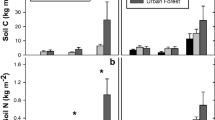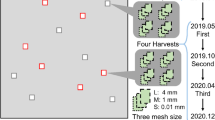Abstract
We studied soil processes along an urban to rural gradient. To determine the ecosystem response to the urban soil environment, we measured (1) leaf litter decomposition rates using a reference leaf litter, and (2) net N-mineralization and net nitrification rates using paired in situ soil cores. A significant trend toward slower litter decomposition rates toward the urban end of the gradient was observed. In addition, percent ash-free dry mass remaining of the litter was significantly higher during the course of the study but was not statistically significant at the final sampling date. Litter C:N ratio had a complex response with respect to degree of urban land use, and litter % N did not differ between land-use types. Litter decomposition rates were not significantly correlated with observed soil physicochemical and biological characteristics but were influenced by soil moisture and soil organic matter. Net N-mineralization rates were higher in urban soils. Net nitrification rates did not differ with land-use type. Net N-mineralization rates were positively correlated with soil temperature, indicating a response to the urban heat island effect. Net N-mineralization rates were negatively correlated with the numbers of higher trophic level nematodes.



Similar content being viewed by others
References
Adams MA, Attiwill PM (1982) Nitrogen mineralization and nitrate reduction in forest soils. Soil Biol Biochem 14:197–202
Alig RJ, Healy RG (1987) Urban and built-up land area changes in the United States: an empirical investigation of determinants. Land Econ 63:215–226
Allen-Morley CR, Coleman DC (1989) Resilience of soil biota in various food webs to freezing perturbations. Ecology 70:1127–1141
Baxter JW, Pickett STA, Dighton J, Carreiro MM (2002) Nitrogen and phosphorus availability in oak forest stands exposed to contrasting anthropogenic impacts. Soil Biol Biochem 34:623–633
Berry J (1991) Urbanization. In: Turner B II, Clark W, Kates R, Richards J, Mathews J, Meyer WB (eds) The earth as transformed by human action. Cambridge University Press, New York, pp 103–119
Binkley D, Hart SC (1989) The components of nitrogen availability assessment in forest soils. Adv Soil Sci 10:57–112
Blair JM (1988) Nitrogen, sulfur, and phosphorus dynamics in decomposing deciduous leaf litter in the southern Appalachians. Soil Biol Biochem 20:693–701
Bose RC (1949) Least squares aspects of analysis of variance. University of North Carolina, Chapel Hill
Botkin DB, Beveridge CE (1997) Cities as environments. Urban Ecosyst 1:3–19
Cotrufo MF, De Santo AV, Alfani A, Bartoli G, De Cristofaro A (1995) Effects of urban heavy metal pollution on organic matter decomposition in Quercus ilex L. woods. Environ Pollut 89:81–87
Ferris H, Bongers T, de Goede RGM (2001) A framework for soil food web diagnostics: extension of the nematode faunal analysis concept. Appl Soil Ecol 18:13–29
Gilbert OL (1989) The ecology of urban habitats. Chapman and Hall, New York
Goldman MB, Groffman PM, Pouyat RV, McDonnell MJ, Pickett STA (1995) CH4 uptake and N availability in forest soils along an urban to rural gradient. Soil Biol Biochem 27:281–286
Groffman PM, Crawford MK (2003) Denitrification potential in urban riparian zones. J Environ Qual 32:1144–1149
Groffman PM, Boulware NJ, Zipperer WC, Pouyat RV, Band LE, Colosimo MF (2002) Soil nitrogen cycle processes in urban riparian zones. Environ Sci Technol 36:4547–4552
Hedlund K, Ohrn MS (2000) Tritrophic interactions in a soil community enhance decomposition rates. Oikos 88:585–591
Hicks NG, Pearson SM (2003) Salamander diversity and abundance in forests with alternative land use histories in the Southern Blue Ridge Mountains. For Ecol Manage 177:117–130
Huhta V, Persson T, Setälä H (1998) Functional implications of soil fauna diversity in boreal forests. Appl Soil Ecol 10:277–288
Laakso J, Setälä H (1999) Population- and ecosystem-level effects of predation on microbial-feeding nematodes. Oecologia 120:279–286
Li X, Poon C-S, Liu PS (2001) Heavy metal concentration of urban soils and street dusts in Hong Kong. Appl Geochem 16:1361–1368
Littell RC, Henry PR, Ammerman CB (1998) Statistical analysis of repeated measures data using SAS procedures. J Anim Sci 76:1216–1231
Lovett GM, Traynor MM, Pouyat RV, Carreiro MM, Zhu W-X, Baxter JW (2000) Atmospheric deposition to oak forests along an urban–rural gradient. Environ Sci Technol 34:4294–4300
McDonnell MJ, Pickett STA, Pouyat RV (1993) The application of the ecological gradient paradigm to the study of urban effects. In: McDonnell MJ, Pickett STA (eds) Humans as components of ecosystems: subtle human effects and the ecology of populated areas. Springer, Berlin Heidelberg New York, pp 175–189
McDonnell MJ, Pickett STA, Groffman PM, Bohlen P, Pouyat RV, Zipperer WC, Parmelee RW, Carreiro MM, Medley K (1997) Ecosystem processes along an urban-to-rural gradient. Urban Ecosyst 1:21–36
Mikola J, Setälä H (1998) Productivity and trophic level biomasses in a microbial based food web. Oikos 82:158–168
Milliken GA, Johnson DE (1984) Analysis of messy data. Designed experiments, vol 1. Lifetime Learning Publications, London
Mitchell CE, Turner MG, Pearson SM (2002) Effects of historical land use and forest patch size on myrmecochores and ant communities. Ecol Appl 12:1364–1377
Oke TR (1995) The heat island of the urban boundary layer: characteristics, causes, and effects. In: Cermak JE (ed) Wind climate in cities. Kluwer, Netherlands, pp 81–107
Olsen JS (1963) Energy stores and the balance of producers and decomposers in ecological systems. Ecology 44:322–331
Paul MJ, Meyer JL (2001) Riverine ecosystems in an urban landscape. Annu Rev Ecol Syst 32:333–365
Pavao-Zuckerman MA (2003) Soil ecology along an urban to rural gradient in the southern Appalachians. Ph.D. dissertation, University of Georgia, Athens, GA
Pickett STA, Cadenasso ML, Grove JM, Nilon CH, Pouyat RV, Zipperer WC, Costanza R (2001) Urban ecological systems: linking terrestrial ecological, physical, and socioeconomic components of metropolitan areas. Annu Rev Ecol Syst 32:127–157
Pouyat RV, McDonnell MJ (1991) Heavy metal accumulations in forest soils along an urban–rural gradient in southeastern New York, USA. Water Air Soil Pollut 57–58:797–807
Pouyat RV, Parmelee RW, Carreiro MM (1994) Environmental effects of forest soil-invertebrate and fungal densities in oak stands along an urban–rural land use gradient. Pedobiologia 38:385–399
Pouyat RV, McDonnell MJ, Pickett STA (1995) Soil characteristics of oak stands along an urban–rural land-use gradient. J Environ Qual 24:516–526
Pouyat RV, McDonnell MJ, Pickett STA (1997) Litter decomposition and nitrogen mineralization in oak stands along an urban–rural land use gradient. Urban Ecosyst 1:117–131
Pouyat RV, Carreirro M, Groffman P, Pavao-Zuckerman MA (in press) Approaches to comparative studies of carbon and nitrogen dynamics in urban ecosystems. In: McDonnell MJ, Hahs A, Breuste J (eds) Comparative ecology of cities and towns. Springer, Berlin Heidelberg New York
Quemada M, Cabrera ML (1997) Temperature and moisture effects on C and N-mineralization from surface applied clover residue. Plant Soil 189:127–137
Robertson GP, Wedin D, Groffman PM, Blair JM, Holland EA, Nadelhoffer KJ, Harris D (1999) Soil carbon and nitrogen availability: nitrogen mineralization, nitrification, and soil respiration potentials. In: Robertson GP, Coleman DC, Bledsoe CS, Sollins P (eds) Standard soil methods for long-term ecological research. Oxford University Press, New York, pp 258–271
Rodrigo A, Recous S, Neel C, Mary B (1997) Modelling temperature and moisture effects on C–N transformations in soils: comparison of nine models. Ecol Model 102:325–339
Scott MC, Helfman GS (2001) Native invasions, homogenization, and the mismeasure of integrity of fish assemblages. Fisheries 26:6–15
Scott MC, Helfman GS, McTammany ME, Benfield EF, Bolstad PV (2002) Multiscale influences on physical and chemical stream conditions across blue ridge landscapes. J Am Water Resour Assoc 38:1379–1392
Sponseller RA, Benfield EF (2001) Influences of land use on leaf breakdown in southern Appalachian headwater streams: a multiple-scale analysis. J North Am Benthol Soc 20:44–59
Sponseller RA, Benfield EF, Valett HM (2001) Relationships between land use, spatial scale and stream macroinvertebrate communities. Freshw Biol 46:1409–1424
Steinberg DA, Pouyat RV, Parmelee RW, Groffman PM (1997) Earthworm abundance and nitrogen mineralization rates along an urban–rural land use gradient. Soil Biol Biochem 29:427–430
Sutherland AB, Meyer JL, Gardiner EP (2002) Effects of land cover on sediment regime and fish assemblage structure in four southern Appalachian streams. Freshw Biol 47:1791–1805
Swift MJ, Heal OW, Anderson JM (1979) Decomposition in terrestrial ecosystems. Blackwell , Oxford
Turner MG, Pearson SM, Bolstad P, Wear DN (2003) Effects of land-cover change on spatial pattern of forest communities in the Southern Appalachian Mountains (USA). Landscape Ecol 18:449–464
United Nations (1993) World population prospects. United Nations, New York
U.S. Environmental Protection Agency (1983) Nitrogen, ammonia. Method 350.1 (colorimetric, automated phenate). In: Methods for chemical analysis of water and wastes, vol EPA-600/4-79-020. US EPA, Cincinnati, OH
Vitousek P, Gosz JR, Greir CC, Melillo JM, Reiners WA (1982) A comparative analysis of potential nitrification and nitrate mobility in forest ecosystems. Ecol Monogr 52:155–177
Vitousek P, Mooney HA, Lubchenco J, Melillo JM (1997) Human domination of earth’s ecosystems. Science 277:494–499
Wear DN, Turner MG, Naiman RJ (1998) Land cover along an urban–rural gradient: implications for water quality. Ecol Appl 8:619–630
Wright CJ, Coleman DC (2002) Responses of soil microbial biomass, nematode trophic groups, N-mineralization, and litter decomposition to disturbance events in the southern Appalachians. Soil Biol Biochem 34:13–25
Zhu W-X, Carreiro MM (1999) Chemoautotrophic nitrification in acidic forest soils along an urban-to-rural transect. Soil Biol Biochem 31:1091–1100
Acknowledgements
This work was supported by the National Science Foundation LTER Program at Coweeta Hydrologic Laboratory. We thank Miguel Cabrera for assistance with statistical analyses. Thanks to Geoff McCann for grinding and prepping leaf litter samples for analysis. Thanks to the Analytical Chemistry Lab, Institute of Ecology for C and N analyses. Miguel Cabrera, Ted Gragson, Paul Hendrix, and Carl Jordan made constructive comments on earlier drafts of the manuscript. Comments by the editor and three anonymous reviewers also improved the manuscript.
Author information
Authors and Affiliations
Corresponding author
Rights and permissions
About this article
Cite this article
Pavao-Zuckerman, M.A., Coleman, D.C. Decomposition of chestnut oak (Quercus prinus) leaves and nitrogen mineralization in an urban environment. Biol Fertil Soils 41, 343–349 (2005). https://doi.org/10.1007/s00374-005-0841-z
Received:
Revised:
Accepted:
Published:
Issue Date:
DOI: https://doi.org/10.1007/s00374-005-0841-z




